Record milk and beef prices and rising replacement heifer prices offer commercial dairy producers options to manage their herd inventory. Herds with adequate supplies of replacement heifers have greater opportunity to cull low-producing cows and take advantage of high beef prices.
In addition to culling decisions, breeding decisions can be customized to meet future needs. Maintaining an adequate inventory of high genetic merit replacement animals allows breeders to consider the possibility of mating a subset of dairy cows with beef semen to capitalize on the higher market prices paid for beef cattle.
The stock market provides an interesting analogy. There are many online tools available to investors. They look at past performance of stocks and predict what the future value of a certain investment may be. This information is the basis for decisions to buy or sell.
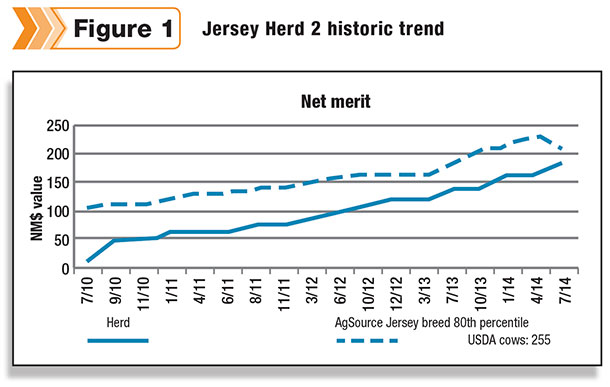
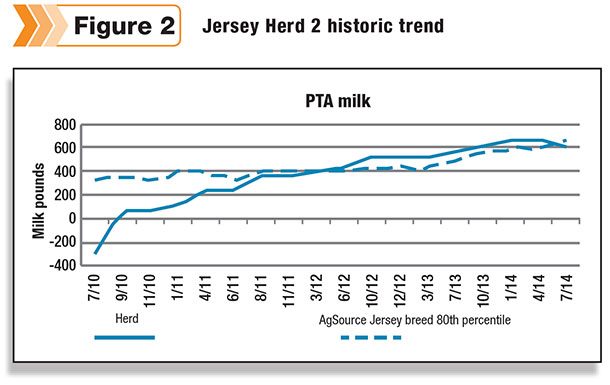
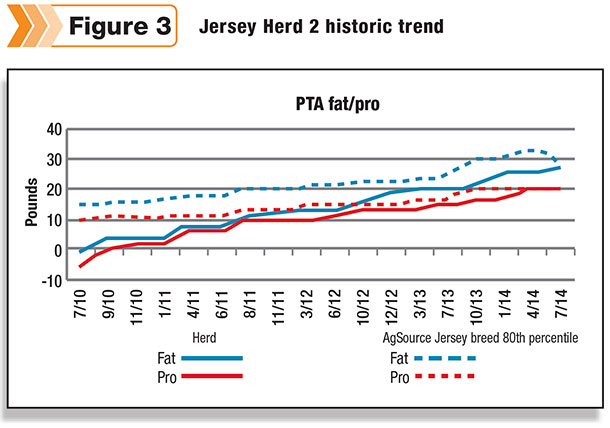
The outcome of the decision is often only as good as the quality of the tools used to make the decision. However, even when utilizing vast amounts of reliable information, there is always an element of unpredictability when attempting to predict the future. That is why investors constantly compare actual results to expected outcomes when evaluating investment tools.
The same is true when managing genetics and herd inventory. In order to make the most informed decisions, dairy producers rely on a wealth of genetic information. Decision support tools provided by DHI, A.I. companies and providers of genomic testing are geared toward helping make the most profitable decisions.
To ensure you are making the best decisions, however, you should closely monitor results and decide if goals are actually being achieved. Let’s examine a couple of herds and evaluate several aspects of their genetics program using information obtained from the AgSource genetic summary report.
Evaluate the current genetics in the herd
The first step is to make sure the genetics of your cows and heifers are in line with other cows and heifers in the breed. To accomplish this, take a look at the overall snapshot of the cows and heifers in the herd and compare the genetic and inbreeding values to determine how your animals rank against animals of the same breed.
Table 1 illustrates a Jersey herd with good genetics and shows that for most traits, the herd ranks between the 50th and 80th percentile when compared to all other Jersey cows. For example, the NM$ average for Jersey Herd 1 cows is 198 NM$, which ranks them midway between the 50th and the 80th percentile for all cows, which is 266 NM$.
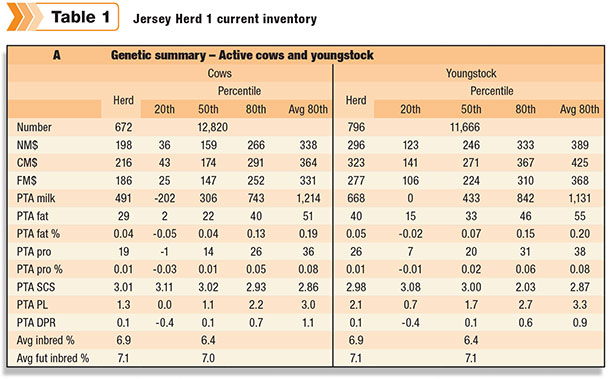
Although the herd is doing well, the average NM$ value of the top 80th percentile is 338 NM$. This leaves significant room for improvement. The summary reviews various traits and compares how they rank.
In addition to the genetic values, the inbreeding percentage is listed, and in the case of this herd, the percentage is higher than the average Jersey cows and heifers (6.9 percent for cows and 6.9 percent for heifers) compared to all other cows and heifers (6.4 percent for cows and 6.4 percent for heifers).
Table 2 shows a similar NM$ Jersey herd. Despite having a comparable NM$ value, Herd 2’s PTA productive life (PL) is lower than Herd 1. The inbreeding percent of cows and heifers in Herd 2 is also lower than in Herd 1 and below the average Jersey inbreeding percentage.
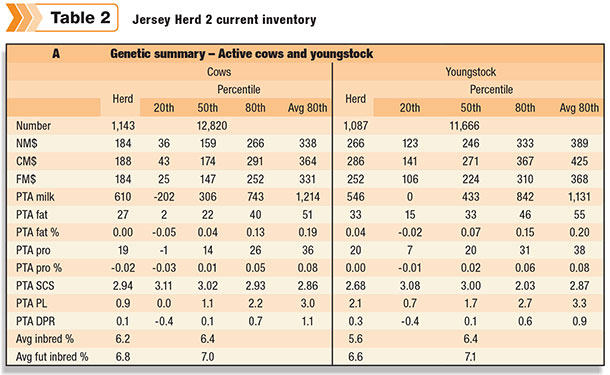
A follow-up analysis can be done, looking at the trends of certain traits over time and comparing the herd’s trend against herds in the 80th percentile. When looking at Figures 1-3, Jersey Herd 2 was performing below the 80th-percentile Jersey herds when tracking net merit, but the herd is improving more rapidly compared to the 80th-percentile herds for PTA milk, fat and protein.
The genetics of the current herd, coupled with the history on some of the traits, will describe the current situation. It will also tell you if the herd has been keeping pace with the top 80th-percentile herds.
Evaluate how well your inbreeding management program is working
In most cases, producers rely on mating software provided through an A.I. company to manage their inbreeding levels. Inbreeding levels are generally taken into account as part of the mating recommendation.
An important thing to consider is that a mating recommendation is just that: a “recommendation.” In order for mating software to work, it is key that the recommended sires are actually the ones that are used. There are possibilities to make mistakes during the breeding process, and when semen inventories are running low, other bulls may be substituted.
There are several ways to keep a handle on how well the mating program and the actual breeding process are working. Let’s start by looking at the current herd’s distribution of percent of cows inbred by different categories. Figures 4 and 5 show the inbreeding distribution of Jersey Herd 1 and Jersey Herd 2.
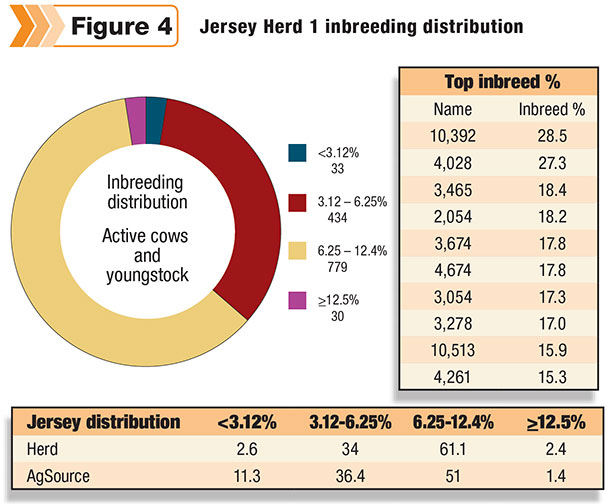
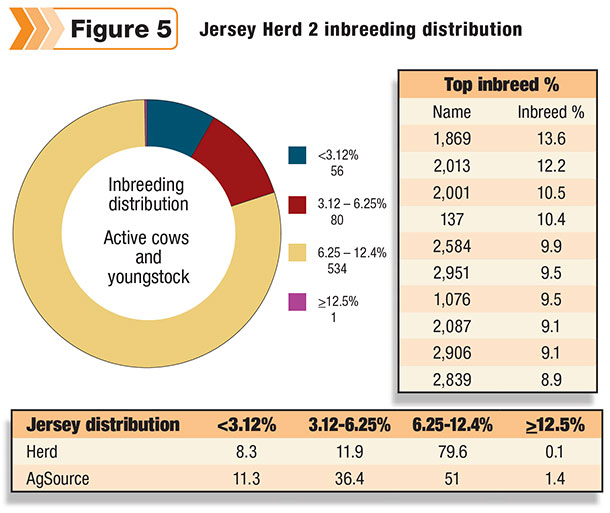
In Figures 4 and 5, both Herd 1 and Herd 2 have a high percentage of cows with inbreeding percent greater than 6.25 percent and less than 12.5 percent compared to other Jersey herds. However, Herd 1 has a larger percent of cows greater than 12.5 percent inbred, which should be a concern because of the close relationship.
Herd 2, on the other hand, has done a good job managing the number of cows greater than 12.5 percent inbred. In both herds, closer attention will need to be paid to managing the inbreeding levels greater than 6.25 percent.
This can be as simple as ensuring mating recommendations are followed or making a change in the mating program settings to ensure higher inbreeding levels are avoided. One other possibility is to look for the predominant lines of genetics in the herd and find some A.I. sires that are less related to the animals in the herd but still have equal genetic merit.
Evaluate how the genetics in your herd translate to actual performance
Genetics play an important role in achieving higher production levels but also in reducing the number of cows with udder health and fertility problems. Commercial producers question how much value genetics truly bring to the table relative to other management practices in which they can invest money. Taking a look at how cows of different genetic levels perform in your herd can shine a light on what opportunities exist.
Tables 3 and 4 provide an analysis showing a breakdown of the milking herd in four NM$ quartiles. For each quartile, we take a look at the phenotypic data. Both Herd 1 and Herd 2 have similar NM$ quartiles.


Although Herd 2 has higher production levels than Herd 1, what you are really after is finding out how Quartile 1 cows are performing compared to Quartile 4 cows within the herd. In both herds, in terms of production, Quartile 1 cows are outperforming Quartile 4 cows.
In Herd 1 there is also a significant difference in udder health, represented as linear score for somatic cell count (LSSCC), and days open. In both cases, investing money in superior genetics is showing a significant payoff.
Based on both the genetic and phenotypic data, producers can make decisions as to what type of genetics they wish to invest in and monitor the payback. In the case of the two example herds, investments in genetics to improve production have paid off for both herds. In the case of Herd 1, there are also significant differences in udder health and days open.
What are the genetics of the next generation of replacement animals?
While the genetics of the cows and heifers in the herd cannot be changed, the introduction of new genetics can have an impact. Therefore, the final piece of analysis is to take a look at the genetics that will be coming into the herd. The key is to look for those traits you consider important and make certain you are obtaining the levels of progress you are expecting to make.
Evaluating the genetics of the calves and heifers in the herd is an important aspect for those producers who have low involuntary culling rates. They can cull more heavily based on production or other management areas they wish to improve.
Knowing how many heifers and what genetics are available, compared to the cows currently in the milking herd, will indicate the amount of genetic progress that can be made replacing a milking cow with a heifer.
In the example in Table 5 , you can clearly see that the calves born most recently are significantly higher in NM$ than the heifers due to calve. The difference is mainly driven by traits such as PTA milk, fat and protein. Traits such as PTA SCS, PTA DPR and PTA PL show little or no improvement.

Summary
Evaluating your sire selection criteria and breeding decisions should be an annual task. As described above, there are four key elements to review:
1. Knowing how the genetics of your cows and heifers stack up to 80th-percentile cows and heifers in the breed provides you with a current status and shows you the amount of opportunity for improvement. In addition, reviewing your herd’s trend, compared to the 80th-percentile herd’s trend on various traits, will shed a light on how fast you are improving and if you are keeping up with other herds.
2. As relationships between sires continue to increase, you have to watch the inbreeding level in your herd and make changes if needed. Monitoring inbreeding levels, screening out the high cows and finding the reasons why they are high is an important annual task. Discuss high levels of inbreeding with your A.I. representative.
3. To measure how the investment in genetics shows you a return on investment, compare the genetics and actual performance of the highest-NM$ cows with the lowest. Cows with the highest genetic levels should be outperforming those with the lowest levels.
4. And the final piece is to review the genetics you are currently using (service sires) and measure how the genetics of your replacement heifers and calves are improving. The genetics of your replacement heifers should be improving as the animals get younger, and the heifers due to calve should have higher genetics than the cows currently in the milking herd.
A successful genetic management program is based on good analytical information, and it all starts with accurate identification of each animal and its sire and dam. Evaluating your overall genetic program allows you to make informed decisions about the criteria used to select A.I. sires, determine matings, consider use of sexed or beef semen and, finally, identify animals that should be culled. PD
Robert Fourdraine holds a Ph.D. in animal science from Texas A&M.

-
Robert Fourdraine
- Vice President of DHI Operations
- AgSource Cooperative Services







